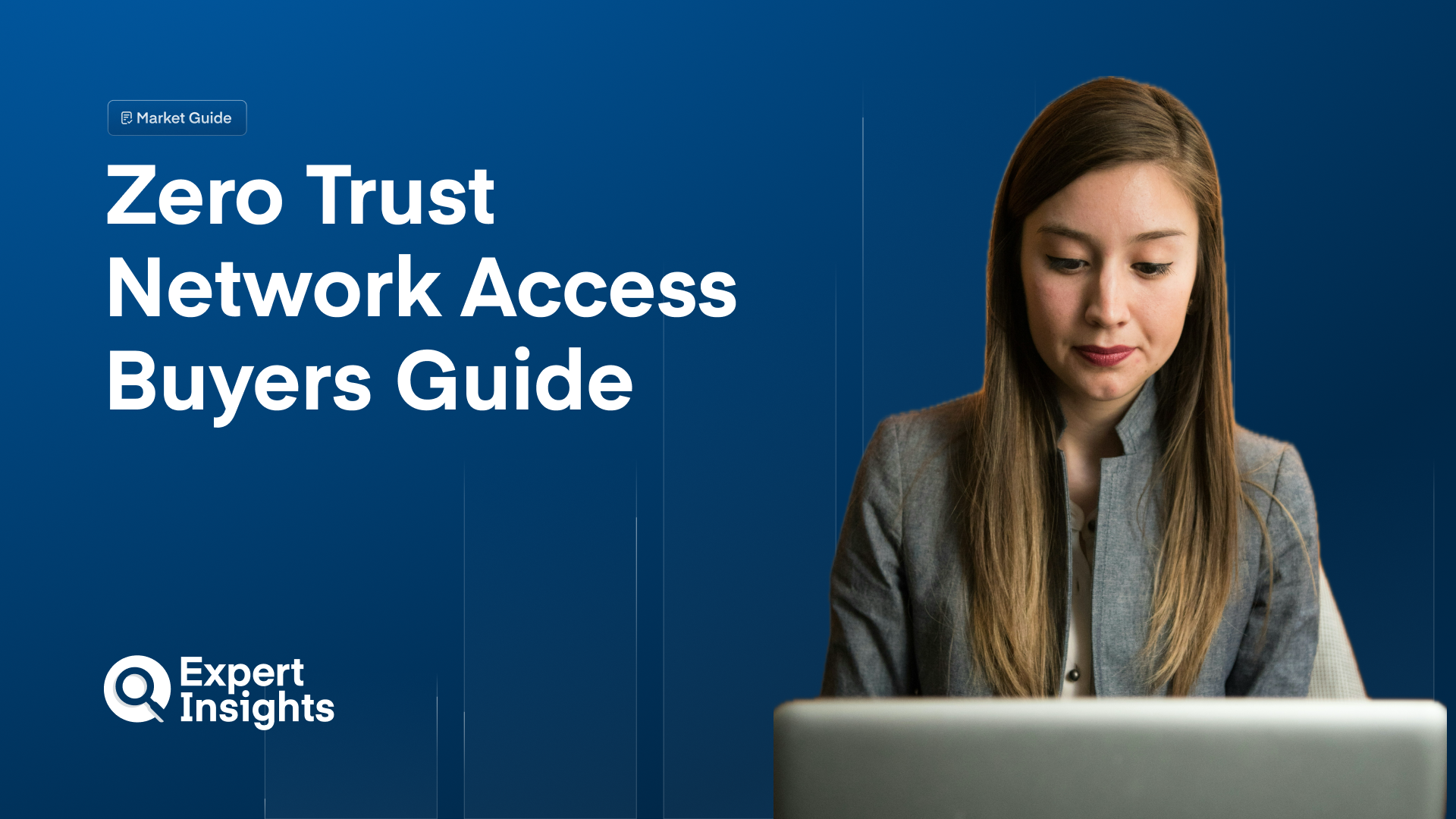
Zero Trust Network Access (ZTNA) Buyers’ Guide 2024
How to choose the right Zero Trust Network Access software.

Zero Trust (ZT) is a phrase that crops up across cybersecurity principles. It is a way of raising security standards across organizations, ensuring that users are not automatically granted access. Zero Trust Network Access (ZTNA) was once a replacement for VPNs, now it’s much more than that.
What Does ZTNA mean?
- ZT is the principle that means not automatically trusting a user but requiring them to be authenticated before granting them access.
- ZTNA is this philosophy when applied to your network, providing users secure access to applications, data, and services.
In this article, we’ll cover:
- Why ZTNA Matters
- How ZTNA works
- Best Providers
- ZTNA Key principles
- Benefits of ZTNA
- Features Checklist
- Future Trends
- Further Reading
Why It Matters:
- ‘60% of organizations are planning to implement Zero Trust models by 2025’ (Gartner)
- ‘72% of respondents describe zero trust security as important, while 27% say it’s critical’ (Okta)
- ‘91% or respondents stated that integrated zero-trust ecosystems would allow them to respond more quickly to security incidents, and 90% said it would allow them to meet compliance requirements’ (BeyondTrust)
How It Works: ZT is a security principle, rather than a specific process. Provides who adhere to ZT principles will use the same techniques to improve security.
ZTNA Key Principles:
- Application Access is isolated from network access: by isolating these two processes, the risk of device or network compromise is greatly reduced. Access is only granted to authorized users.
- Outbound–only connections: this ensures that network and infrastructure cannot be identified by unauthorized users.
- Micro-Segmentation: this ensures that users are authorized for each process they attempt, rather than granting them unlimited access across the whole network. You might see this referred to as lateral access.
- User–to-application approach: end to end TLS-micro tunnels are used rather than MPLS. This puts the focus on users and individual security transactions, rather than a broad approach to security.
These principles can then be used practically, across a number of security policies and techniques. Some of these will include:
- Continuous Verification: Always verify access rights and continuously monitor user activities. This ensures that use access does not creep in to unpermitted areas or for longer than is necessary.
- Least Privilege Access: Grant the minimum level of access necessary for users to perform their tasks. This restricts the access and impact that a user can have, ensuring that security is prioritized throughout.
- Multi-Factor Authentication (MFA): This requires a user to confirm their identity in at least two ways. Rather than just having the correct login details, they must also have access to a verified device or use biometrics to confirm identity.
- Endpoint Security: Secure all endpoints, such as mobile devices, laptops, and desktops, that connect to the network.
Best Providers:
The Top 10 Zero Trust Network Access (ZTNA) Solutions
- Twingate ZTNA
- NordLayer
- Akamai
- Cisco
- Citrix
Benefits of ZTNA:
- Enhanced Security Posture: Provides robust security by continuously verifying user identities and monitoring activities. This means that only users with verified access will be granted that access.
- Reduced Attack Surface: Limits lateral movement within the network through micro-segmentation. This means that verified users have a way into the area they need, but they can’t then move from here into other network areas.
- Improved Compliance: Helps meet regulatory requirements for data protection and access control. ZTNA uses a range of techniques to provide security, ensuring that you can meet a range of compliance expectations.
- Scalable Access Control: Easily scales with organizational growth and evolving security needs. ZTNA ensures that users are only granted the access they need even as the number of overall users increases.
- Remote Work Facilitation: Securely supports remote work by ensuring secure access to resources from any location. As ZTNA is concerned with the relation between a specific user and the organization, if that user is verified, their geographical location is irrelevant.
- Real-Time Threat Detection: Identifies and responds to threats in real-time, reducing the potential for breaches. This drives down the amount of time taken to discover a malicious actor who has gained network access.
Features Checklist:
- Continuous Monitoring: Real-time monitoring and analysis of user activities and network traffic. This is essential. Without it, you will be unable to ensures that users are only accessing permitted areas.
- Identity and Access Management (IAM): Robust IAM capabilities for managing user identities and access rights. This should facilitate a range of identities (including user and machine), ensuring security across the board.
- Micro-Segmentation: Tools to implement and manage micro-segmentation within the network. This granular approach ensures that users have access to the areas they need, without being able to stray into unrestricted territories.
- Multi-Factor Authentication (MFA): Support for MFA to enhance security. This is a quick and easy way for users to verify identity and gain access.
- Scalability: Ability to scale as organizations grow, without creating gaps or vulnerabilities within your security infrastructure.
- Integration: Compatibility with existing security infrastructure and applications. This ensures that you can apply ZTNA policies consistently across your network, rather than having different policies in different areas.
- Compliance: Features to ensure compliance with industry regulations and standards. This will include prebuilt policy templates, outlining best practice and compliance expectations.
- Cost: Transparent pricing models and total cost of ownership. ZTNA is an essential part of your network security, and therefore not something you want to skimp on. However, the costings need to be transparent to prevent you from looking for an alternative provider in a year’s time.
Our Recommendations: As ZTNA is characterised by a set of principles, rather than a checklist of features, when selecting the right solution for your needs, you need to consider more than just its capabilities.
- For large enterprises: Choose a solution that offers robust scalability, continuous monitoring, and comprehensive endpoint security to handle extensive networks efficiently. Segmentation and least-privilege is important for organizations with many users and network areas.
- For security-focused organizations: Ensure the tool provides advanced threat detection, micro-segmentation, and multi-factor authentication features. This can be enhanced with robust endpoint detection and protection.
- For compliance needs: Opt for solutions that support relevant industry standards and regulatory requirements. As many companies advertise Zero Trust capabilities, it is worth digging into what this means in practice.
- For integration with existing systems: Select tools that seamlessly integrate with your current security infrastructure. This ensures that you can proactively utilize different tools to enhance security coverage, rather than having tools operate in isolation.
- For ease of use: Choose solutions that offer intuitive management interfaces and easy policy configuration. There should be preset policies that demark best practices, whilst allowing room for you to configure specific policies.
Future Trends:
- Zero Trust used against us: Akamai’s Pavel Gurvich said that he expects “to see more sophisticated attacks, and for some of the Zero Trust principles that we deploy and think are good ideas, to be used against us.”
- AI and Machine Learning: Enhanced capabilities using AI to improve threat detection, anomaly detection, and automated responses. This use of AI / ML will make it easier for systems to identify threats, with a high degree of accuracy (resulting in fewer false positives).
- Focus on Identity-Centric Security: As work habits evolve and users log in from a wider range of locations and devices, we will see an evolution in the way that ZTNA integrates with identity verification solutions.
- Automation and Orchestration: Growing adoption of automation tools for enforcing ZTNA policies and responding to threats. As we see widespread smart automation, human workload will reduce, while security and compliance will remain robust.
Further Reading:





